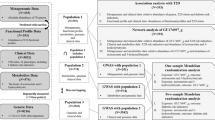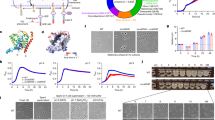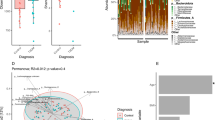Abstract
We describe here the role of muramidases present in clones of metagenomic DNA that result in cell aggregation and biofilm formation by Escherichia coli. The metagenomic clones were obtained from uncultured Lachnospiraceae-affiliated bacteria resident in the foregut microbiome of the Tammar wallaby. One of these fosmid clones (p49C2) was chosen for more detailed studies and a variety of genetic methods were used to delimit the region responsible for the phenotype to an open reading frame of 1425 bp. Comparative sequence analysis with other fosmid clones giving rise to the same phenotype revealed the presence of muramidase homologues with the same modular composition. Phylogenetic analysis of the fosmid sequence data assigned these fosmid inserts to recently identified, but uncultured, phylogroups of Lachnospiraceae believed to be numerically dominant in the foregut microbiome of the Tammar wallaby. The muramidase is a modular protein containing putative N-acetylmuramoyl--alanine amidase and an endo-β-N-acetylglucosaminidase catalytic module, with a similar organization and functional properties to some Staphylococcal autolysins that also confer adhesive properties and biofilm formation. We also show here that the cloned muramidases result in the production of extracellular DNA, which appears to be the key for biofilm formation and autoaggregation. Collectively, these findings suggest that biofilm formation and cell aggregation in gut microbiomes might occur via the concerted action of carbohydrate-active enzymes and the production of extracellular DNA to serve as a biofilm scaffold.
Similar content being viewed by others
Log in or create a free account to read this content
Gain free access to this article, as well as selected content from this journal and more on nature.com
or
Accession codes
References
Akin DE . (1976). Ultrastructure of rumen bacterial attachment to forage cell walls. Appl Environ Microbiol 31: 562–568.
Allesen-Holm M, Barken KB, Yang L, Klausen M, Webb JS, Kjelleberg S et al. (2006). A characterization of DNA release in Pseudomonas aeruginosa cultures and biofilms. Mol Microbiol 59: 1114–1128.
Allignet J, Aubert S, Dyke KGH, Solh NE . (2001). Staphylococcus caprae strains carry determinants known to be involved in pathogenicity: a gene encoding an autolysin-binding fibronectin and the ica operon involved in biofilm formation. Infect Immun 69: 712–718.
Anderson KL . (2003). The complex world of gastrointestinal bacteria. Can J Anim Sci 83: 409–427.
Brown S . (1992). Engineered iron oxide-adhesion mutants of the Escherichia coli phage 1 receptor. Proc Natl Acad Sci USA 89: 8651–8655.
Bryant MP . (1986a). Genus XIII. Lachnospira. In: Sneath PHA, Mair NS, Sharpe ME, Holt JG (eds). Bergey's Manual of Systematic Bacteriology. illiams & Wilkins: Baltimore, MD.
Bryant MP . (1986b). Genus IV. Butyrivibrio, In: Sneath PHA, Mair NS, Sharpe ME, Holt JG (eds). Bergey's Manual of Systematic Bacteriology. illiams & Wilkins: Baltimore, MD.
Chhour K-L, Nadkarni MA, Byun R, Martin FE, Jacques NA, Hunter N . (2005). Molecular analysis of microbial diversity in advanced caries. J Clin Microbiol 43: 843–849.
Costerton JW, Lewandowski Z, Caldwell DE, Korber DR, Lappin-Scott HM . (1995). Microbial biofilms. Annu Rev Microbiol 49: 711–745.
Dell’Anno A, Bompadre S, Danovaro R . (2002). Quantification, base composition, and fate of extracellular DNA in marine sediments. Limnol Oceanogr 47: 899–905.
Dell′Anno A, Danovaro R . (2005). Extracellular DNA plays a key role in deep-sea ecosystem functioning. Science 309: 2179.
Downes J, Munson MA, Radford DR, Spratt DA, Wade WG . (2002). Shuttleworthia satelles gen. nov., sp. nov., isolated from the human oral cavity. Int J Syst Evol Microbiol 52: 1469–1475.
Eckburg PB, Bik EM, Bernstein CN, Purdom E, Dethlefsen L, Sargent M, et al. (2005). Diversity of the human intestinal microbial flora. Science 308: 1635–1638.
Flemming HC, Wingender J . (2001). Relevance of microbial extracellular polymeric substances (EPSs)—Part II: technical aspects. Water Sci Technol 43: 9–16.
Frank DN, StAmand AL, Feldman RA, Boedeker EC, Harpaz N, Pace NR . (2007). Molecular–phylogenetic characterization of microbial community imbalances in human inflammatory bowel diseases. Proc Natl Acad Sci USA 104: 13780–13785.
Harmsen M, Lappann M, Knochel S, Molin S . (2010). Role of extracellular DNA during biofilm formation by Listeria monocytogenes. Appl Environ Microbiol 76: 2271–2279.
Heilmann C, Hussain M, Peters G, Götz F . (2007). Evidence for autolysin-mediated primary attachment of Staphylococcus epidermidis to a polystyrene surface. Mol Microbiol 24: 1013–1024.
Hell W, Meyer HG, Gatermann SG . (1998). Cloning of aas, a gene encoding a Staphylococcus saprophyticus surface protein with adhesive and autolytic properties. Mol Microbiol 29: 871–881.
Hold GL, Pryde SE, Russell VJ, Furrie E, Flint HJ . (2002). Assessment of microbial diversity in human colonic samples by 16S rDNA sequence analysis. FEMS Microbiol Ecol 39: 33–39.
Huang X, Madan A . (1999). CAP3: A DNA sequence assembly program. Genome Res 9: 868–877.
Lappann M, Claus H, Alen T, Harmsen M, Elias J, Molin S et al. (2010). A dual role of extracellular DNA during biofilm formation of Neisseria meningitidis. Mol Microbiol 75: 1355–1371.
Markowitz VM, Ivanova NN, Szeto E, Palaniappan K, Chu K, Dalevi D et al. (2008). IMG/M: a data management and analysis system for metagenomes. Nucleic Acids Res 36: 534–538.
Markowitz VM, Korzeniewski F, Palaniappan K, Szeto E, Werner G, Padki A et al. (2006). The integrated microbial genomes (IMG) system. Nucleic Acids Res 34: 344–348.
McHardy AC, Martin HG, Tsirigos A, Hugenholtz P, Rigoutsos I . (2007). Accurate phylogenetic classification of variable-length DNA fragments. Nat Meth 4: 63–72.
Miron J, Ben-Ghedalia D, Morrison M . (2001). Invited review: adhesion mechanisms of rumen cellulolytic bacteria. J Dairy Sci 84: 1294–1309.
Moore WEC, Johnson JL, Holdeman LV . (1976). Emendation of Bacteroidaceae and Butyrivibrio and descriptions of Desulfornonas gen. nov. and ten new species in the genera Desulfomonas, Butyrivibrio, Eubacterium, Clostridium, and Ruminococcus. Int J Syst Bacteriol 26: 238–252.
Morrison M, Pope PB, Denman SE, McSweeney CS . (2009). Plant biomass degradation by gut microbiomes: more of the same or something new? Curr Opin Biotechnol 20: 358–363.
Morrison M, Miron J . (2000). Adhesion to cellulose by Ruminococcus albus: a combination of cellulosomes and Pil-proteins? FEMS Microbiol Lett 185: 109–115.
Mosoni P, Gaillard-Martinie B . (2001). Characterization of a spontaneous adhesion-defective mutant of Ruminococcus albus strain 20. Arch Microbiol 176: 52–61.
Nemoto K, Hirota K, Murakami K, Taniguti K, Murata H, Viducic D et al. (2003). Effect of Varidase (streptodornase) on biofilm formed by Pseudomonas aeruginosa. Chemotherapy 49: 121–125.
Niemeyer J, Gessler F . (2002). Determination of free DNA in soils. J Plant Nutr Soil Sci 165: 121–124.
Noguchi H, Park J, Takagi T . (2006). MetaGene: prokaryotic gene finding from environmental genome shotgun sequences. Nucleic Acids Res 34: 5623–5630.
Pegden RS, Larson MA, Grant RJ, Morrison M . (1998). Adherence of the gram-positive bacterium Ruminococcus albus to cellulose and identification of a novel form of cellulose-binding protein which belongs to the Pil family of proteins. J Bacteriol 180: 5921–5927.
Petersen FC, Pecharki D, Scheie AA . (2004). Biofilm mode of growth of Streptococcus intermedius favored by a competence-stimulating signaling peptide. J Bacteriol 186: 6327–6331.
Petersen FC, Tao L, Scheie AA . (2005). DNA binding-uptake system: a link between cell-to-cell communication and biofilm formation. J Bacteriol 187: 4392–4400.
Pope PB, Denman SE, Jones M, Tringe SG, Barry K, Malfatti SA et al. (2010). Adaptation to herbivory by the Tammar wallaby includes bacterial and glycoside hydrolase profiles different to other herbivores. Proc Natl Acad Sci USA. doi: 10.1073/pnas.1005297107.
Qin Z, Ou Y, Yang L, Zhu Y, Tolker-Nielsen T, Molin S et al. (2007). Role of autolysin-mediated DNA release in biofilm formation of Staphylococcus epidermidis. Microbiology 153: 2083–2092.
Rakotoarivonina H, Larson MA, Morrison M, Girardeau J-P, Gaillard-Martinie B, Forano E et al. (2005). The Ruminococcus albus pilA1–pilA2 locus: expression and putative role of two adjacent pil genes in pilus formation and bacterial adhesion to cellulose. Microbiology 151: 1291–1299.
Schembri MA, Klemm P . (1998). Heterobinary adhesins based on the Escherichia coli FimH fimbrial protein. Appl Environ Microbiol 64: 1628–1633.
Schwiertz A, Hold GL, Duncan SH, Gruhl B, Collins MD, Lawson PA et al. (2002). Anaerostipes caccae gen. nov., sp. nov., a new saccharolytic, acetate-utilising, butyrate-producing bacterium from human faeces. Syst Appl Microbiol 25: 46–51.
Spoering AL, Gilmore MS . (2006). Quorum sensing and DNA release in bacterial biofilms. Curr Opin Microbiol 9: 133–137.
Sutherland IW . (2001). The biofilm matrix—an immobilized but dynamic microbial environment. Trends Microbiol 9: 222–227.
Suzuki H, Daimon M, Awano T, Umekage S, Tanaka T, Kikuchi Y . (2009). Characterization of extracellular DNA production and flocculation of the marine photosynthetic bacterium Rhodovulum sulfidophilum. Appl Microbiol Biotechnol 84: 349–356.
Valle J, Mabbett AN, Ulett GC, Toledo-Arana A, Wecker K, Totsika M et al. (2008). UpaG, a new member of the trimeric autotransporter family of adhesins in uropathogenic Escherichia coli. J Bacteriol 190: 4147–4161.
Weimer PJ, Price NPJ, Kroukamp O, Joubert L-M, Wolfaardt GM, Van Zyl WH . (2006). Studies of the extracellular glycocalyx of the anaerobic cellulolytic bacterium Ruminococcus albus 7. Appl Environ Microbiol 72: 7559–7566.
Whitchurch CB, Tolker-Nielsen T, Ragas PC, Mattick JS . (2002). Extracellular DNA required for bacterial biofilm formation. Science 295: 1487.
Wu J, Xi C . (2009). Evaluation of different methods for extracting extracellular DNA in biofilm matrix. Appl Environ Microbiol 75: 5390–5395.
Zhongtang Y, Yu M, Morrison M . (2005). Improved serial analysis of V1 ribosomal sequence tags (SARST-V1) provides a rapid, comprehensive, sequence-based characterization of bacterial diversity and community composition. Environ Microbiol 8: 603–611.
Acknowledgements
The Tammar wallaby project is partially supported by CSIRO's Office of the Chief Executive (OCE) Science Leader programme (awarded to MM), a CSIRO OCE Postdoctoral Fellowship (awarded to PBP) and the United States Department of Energy-Joint Genome Institute Community Sequencing Programme. We are especially grateful to the support from Lyn Hind (CSIRO Australia), who assisted in sample collection. This work was performed in part under the auspices of the US Department of Energy's Office of Science, Biological and Environmental Research Programme, and by the University of California, Lawrence Berkeley National Laboratory under Contract No. DE-AC02-05CH11231, Lawrence Livermore National Laboratory under Contract No. DE-AC52-07NA27344 and Los Alamos National Laboratory under Contract No. DE-AC02-06NA25396.
Author information
Authors and Affiliations
Corresponding author
Additional information
Supplementary Information accompanies the paper on The ISME Journal website
Rights and permissions
About this article
Cite this article
Pope, P., Totsika, M., Aguirre de Carcer, D. et al. Muramidases found in the foregut microbiome of the Tammar wallaby can direct cell aggregation and biofilm formation. ISME J 5, 341–350 (2011). https://doi.org/10.1038/ismej.2010.116
Received:
Revised:
Accepted:
Published:
Issue date:
DOI: https://doi.org/10.1038/ismej.2010.116
Keywords
This article is cited by
-
The functionality of the gastrointestinal microbiome in non-human animals
Microbiome (2015)
-
Metagenomic Analysis of the Sludge Microbial Community in a Lab-Scale Denitrifying Phosphorus Removal Reactor
Applied Biochemistry and Biotechnology (2015)



